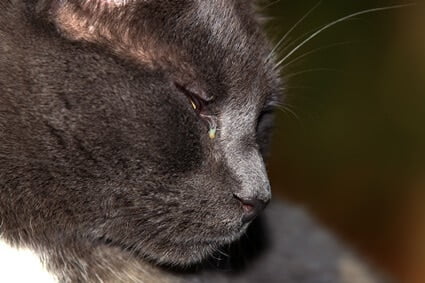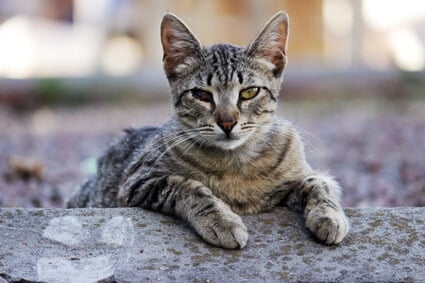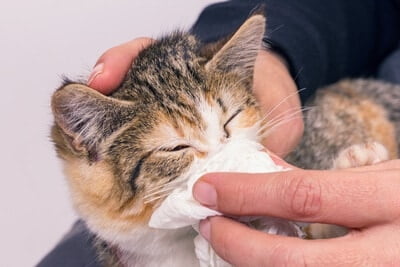You’ve noticed a clear or colored discharge around your cat’s eyes. Eye discharge in cats is usually yellow or brown but can be black or green. You may even notice other symptoms, such as swelling and redness.
Elderly cats have eye discharge due to viral infections such as feline herpesvirus 1 (FHV-1) and bacterial infections such as feline infectious anemia (FIA). Other common causes of leaky, watery eyes in cats include allergies, injuries, parasites, and fungal diseases.
A leaky discharge or eye boogers (gunk) are common among older cats with weaker immune systems. You’ll need to determine why your cat’s eyes are leaking discharge, the symptoms, and the treatments available.
Eye Discharge in Senior Cats Signs And Symptoms
Here are some of the most common causes of weeping eyes in cats:
- Conjunctivitis – Conjunctivitis refers to the inflammation of the eye’s conjunctiva. This is the pink membrane that surrounds the whites of the eyes and lines the inside of the cat’s eyelids. Conjunctivitis causes discharge, squinting, and redness.
- Epiphora – This occurs when there are too many tears in the cat’s eyes. This results in wet and drippy eyes. It can also lead to staining of the fur underneath the eyes.
- Keratitis (or corneal problems) – This is an inflammation of the cornea (the dome-shaped protective layer at the front of the eye). The cornea may look rough, ulcerated, or damaged. This is likely to cause weeping and eye discharge.
Conjunctivitis, epiphora, and keratitis are not the cause of eye discharge. Rather, they are a collection of different symptoms.
What Causes Runny Eyes in Cats?
These conditions can cause cats’ eyes to produce a watery discharge:
- Viral diseases, such as feline herpesvirus 1 (FHV-1) or feline calicivirus
- Systemic bacterial diseases, such as feline infectious anemia (mycoplasma)
- Systemic fungal diseases, such as feline blastomycosis
- A localized fungal or bacterial infection inside the eye
- Dust, dirt, or cat hair aggravating the eye
- Injury
- Allergies
- Irritants
- Tear duct problems
- Parasites, such as toxoplasmosis
If your cat has conjunctivitis, epiphora, or keratitis, at least one of the above causes will be behind the issue.
Conjunctivitis in Cats
Conjunctivitis is the most common eye disorder in cats. It occurs when the pink membrane between the whites of the eye and the eyelid becomes inflamed. This leads to symptoms, such as:
- Squinting
- The conjunctiva becoming very pink/red
- Discharge (clear, yellow, or green)
- Signs of cat flu – drippy nose, lethargy, diarrhea, mild fever, etc.
What causes feline conjunctivitis? Allergies, injuries, or irritating substances. However, conjunctivitis is often caused by a systemic infection that could be bacterial or viral.
Signs of a Systemic Infection
Runny eyes can indicate that your cat may have caught a virus or another contagious disease. This is all the more likely if you recognize the following symptoms:
- The discharge is colored (yellow or green) rather than clear
- The discharge has a mucus-like texture, rather than a watery texture
- The discharge is in both eyes
- The cat has flu-like symptoms
Any systemic infection can cause eye problems, but there are 4 diseases that vets encounter regularly. These include:
Feline Herpesvirus-1
Many cats contract feline herpesvirus 1 (FHV-1) at some point in their lives. Once contracted, FHV-1 can remain dormant for many years. If the virus flares up, this can cause flu-like symptoms and eye discharge.
But what causes HPV-1 to flare up? Often, stress is the cause. Humans with the herpes simplex virus often have a flare-up of cold sores when stressed, so it’s no surprise that stress affects cats similarly.
Noisy households can be a source of stress for older cats. Also, senior cats may struggle to access their food bowl or litter box if they have joint pain. This can cause them to feel very anxious, so ensure your cat can access everything it needs in the household.
As well as causing conjunctivitis, FHV-1 is known to cause keratitis and corneal eye ulcers.
Feline Calicivirus
According to icatcare, feline calicivirus (FCV) is contagious among cats. FCV will almost always cause an upper respiratory tract infection and conjunctivitis (runny, inflamed eyes).
Notable symptoms include:
- Sneezing
- Coughing and gasping for air
- Runny nose
- Lethargy
- Limping
- Reduced appetite
FCV must be treated early. This is partly because many cats pick up secondary bacterial infections that can become life-threatening.
Feline Chlamydia
Feline chlamydia (chlamydohila felis) is also common. In fact, according to VIN, about 30% of cats with conjunctivitis have feline chlamydia.
Cats with chlamydia usually start to get conjunctivitis symptoms in one eye, and the symptoms transfer to both eyes within days. The discharge starts watery but then develops into a thick mucus-like texture.
Another factor unique to feline chlamydia is that cats don’t have flu-like symptoms. They don’t experience a dip in energy levels or loss of appetite. So, even if your cat has no flu-like symptoms, a systemic disease might still be responsible.

Feline Infectious Anemia (Mycoplasma)
Feline infectious anemia (FIA) is a bacterial disease. Essentially, mycoplasmas pass between animals and leech off their blood. Besides conjunctivitis, this disease causes:
- Sudden weight loss
- Lethargy and breathlessness
- Fever
If not treated, FIA can lead to severe anemia and even death.
How Do Contagious Diseases Spread between Cats?
The diseases discussed can spread between cats, but not between cats and humans. Some are highly contagious, such as feline calicivirus.
Cats that go outdoors, or cats that live with other pets, are more likely to contract diseases. Infectious diseases can pass between animals in many ways, such as:
- Sharing water bowls or food bowls
- Licking and grooming each other
- Sharing a litter box, or going to the toilet in the same patch of earth
- Inhaling the same air for extended periods
- Sharing bedding
If your senior cat has runny eyes, you should isolate it from other animals until you’ve had a chance to consult a vet.
Keratitis (Corneal Problems) in Cats
The cornea is the delicate dome-shaped sheath that covers the front of the eye. It acts as a barrier to dust, dirt, and harmful UVA/UVB rays. It also helps to distribute the liquid evenly across the surface of the eye. This helps the eye to stay supple and supports the cat’s vision.
A damaged, inflamed, or ulcerated cornea is referred to as keratitis. The symptoms of keratitis include:
- Very dry eyes
- Sore/burning eyes – redness
- Watery discharge
- An uneven or grainy surface to the eye
- The iris may have a mottled appearance
- There may be an ulcer or small laceration on the front of the eye
Allergies, minor injuries or fungus, can cause corneal problems. For example, a large dust particle or a small piece of cat litter may scrape the surface of the eye.
However, damage to the cornea is more commonly caused by a systemic disease, such as FHV-1. This can occur if FHV-1 is left untreated for an extended period of time.
What is Uveitis?
This rare eye condition occurs when the uveal tract becomes inflamed. This is the middle, internal portion of the eye. If left untreated, it will usually lead to blindness. So, what are the symptoms of uveitis?
- Squinting
- Trying to rub or scratch the eye
- The third eyelid (nictitating membrane) is visible
- Cloudy eye
- Redness
Corneal ulcers can develop into uveitis. In most cases, the initial cause is a systemic disease such as a virus (FHV-1), a fungal disease (feline blastomycosis), or a parasite (toxoplasmosis).
Epiphora in Cats
Epiphora is not a disease in itself. Rather, it is a group of symptoms that different diseases can cause. Essentially, epiphora means a surplus of tears in the eyes.
This can be caused by:
- The tear duct becoming blocked, so tears cannot drain away normally. This is often seen in Persian breeds. These cats have flat faces, so it is difficult for tears to drain away effectively.
- Allergies
- Corneal ulcers/keratitis. This is because the outermost film on the cornea usually helps distribute tears effectively.
- Viral and bacterial infections may cause excess tears.
Cats with epiphora tend to have very wet eyes, and the tears can stain the skin underneath the eyes. In many cases, the wet tears can appear red or brown, which looks like dried-on blood.
To help make your cat more comfortable, you may wish to dab away the wetness every hour with a cotton pad. Be gentle as the eye area is sensitive.
Can Allergies Cause Eye Discharge in Cats?
If your cat’s eyes start weeping, this doesn’t necessarily indicate an infection. Your cat could have an allergy. Allergies can be even more difficult to manage because it’s not always clear what is causing the allergic reaction. Common allergens include:
- Dust Mites
- Flea Bites
- Grass pollen
- Fragrances
- Foods, such as beef and fish
If your cat’s eye discharge is clear and quite watery, this is a good indicator that it could be an allergic reaction. Other symptoms include:
- Coughing and wheezing
- Lethargy
- Itching and scratching
How Is Eye Discharge Treated?
Your vet will determine if the discharge is caused by a systemic infection, injury, allergy, irritant, or something else and then recommend an appropriate treatment. This may include:
Oral Antibiotics
If your cat has a bacterial infection such as mycoplasma, oral antibiotics will be prescribed.
Even if your cat has a viral infection, it may have developed a secondary bacterial infection, so antibiotics may be required.
According to Cornell, the antibiotic clindamycin can also be used to treat the parasitic infection toxoplasmosis.
Idoxuridine, trifluridine, and cidofovir are used to treat viruses in cats.
Eye Drops
These may be used to treat corneal ulcers/keratosis or conjunctivitis. Eye drops may contain antibiotics or ingredients to soothe the inflammation.
Unblocking Tear Ducts
A common cause of epiphora is blocked tear ducts. Your cat may require surgery to unblock them. Sometimes, it is possible to unblock them using a saline solution, but the cat will still be put under a general anesthetic.
Keep your Cat’s Eyes Clean
While your cat is in recovery, you can help keep its eyes clean. You can dab a fresh cotton pad on its eyes every hour to remove the discharge.
Wear gloves or wash your hands thoroughly afterward. Though most systemic diseases cannot spread between cats and humans, the parasite toxoplasmosis is zoonotic.
Vaccinations
As a preventative measure, vaccinations should be given for common, contagious diseases such as FCV and FHV-1. These should be administered to kittens and booster shots every 1-3 years.
Separate your cat from other animals while it’s healing. Most conditions should clear up in 2-3 weeks with the right type of treatment.
Other Eye Problems in Senior Cats
We’ve discussed common medical conditions that cause eye discharge in older cats. When it comes to senior cats, you need to know some other eye conditions. These conditions don’t necessarily cause runny eyes, but they can impact a cat’s quality of life. These include:
Glaucoma
This condition occurs when too much pressure builds up in the eye, causing damage to the optic nerve. The cause of glaucoma is not fully understood, but it seems to be linked to diabetes and kidney disease. Symptoms include extreme sensitivity to light, lethargy, and bulging eyes.
Cataracts
Cloudy eyes can also be a sign of cataracts. A cataract is a film that grows over the eye, sometimes due to diabetes. This film will limit the cat’s vision. The effects can range from very mild to severe.
Sty
This happens when the sebaceous glands in the eyelid become blocked. Poor grooming can contribute to this condition. If your cat has a sty, the eye may be swollen and red, but there won’t be any discharge.

Good Eye Health in Senior Cats
Eye health can deteriorate over time. If you are caring for a senior cat, there are things you can do to promote good eye health. These include:
Diet
Feed your cat a balanced diet. Your cat may also benefit from additional doses of lutein, vitamin C, vitamin E, and zeaxanthin.
Grooming
Keep your cat clean and well-groomed to prevent sties and eye infections. Ensure that there are no long, wispy pieces of hair aggravating the eyes.
Portion Control
Make sure your cat maintains a healthy weight. The average cat needs 20 calories per pound of body weight per day. This will help prevent diabetes and other chronic diseases that can impact eye health.
Why Does My Cat Have Runny Eyes?
Given the variety of causes, you might still be unsure what is wrong with your cat. Take a close look at your cat’s eyes and consider the color and texture of the discharge and the color of the eye itself.
Then, refer to this quick summary:
- Dark pink/red in the outermost edges of the eyeball – The conjunctiva is inflamed, so your cat probably has conjunctivitis. The most common cause is a bacterial or viral infection, but there are other causes.
- Green or yellowish discharge – This usually indicates a bacterial, viral, or fungal infection.
- Clear, watery discharge – Allergy or epiphora (excess tears)
- Clear mucus–like discharge – Systemic infection – bacterial, viral, or fungal
- Brown/red stained fur under the eyes – Epiphora (excess tears)
- Mottled Iris – Keratosis/Corneal ulcer.
There are, of course, exceptions to the above. For example, bacterial/viral infections usually produce an eye discharge with a yellow tinge, but the discharge can occasionally be colorless.


Hello,
We have to clean our 15-year- old Kittys eye daily (named Nittany the Kitney).
Probably started around her 14th birthday. (We saved her from an abusive home when she was 6 months old.) She also has a skin ulcer-which I’m taking her for a Vet appt this Friday. Is there anything that can help her with her poor eye?